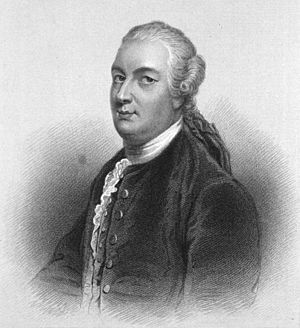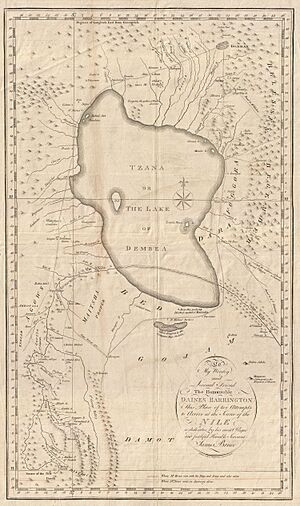James Bruce facts for kids
James Bruce of Kinnaird (born December 14, 1730 – died April 27, 1794) was a Scottish explorer and writer. He spent over ten years exploring North Africa and Ethiopia. He is famous for his travels and for claiming to be the first European to find the source of the Blue Nile. However, this claim was not true. Another explorer, Father Pedro Paez, had found it much earlier in 1618.
Contents
Early Life and Learning

James Bruce was born at his family home in Kinnaird, Stirlingshire, Scotland. He went to Harrow School and then to Edinburgh University. He first planned to become a lawyer.
However, he married the daughter of a wine merchant. This led him to join the wine business instead. Sadly, his wife died in 1754, less than a year after they married. After this, Bruce traveled to Portugal and Spain for the wine trade.
While in Spain, he studied old writings from the Middle East at the Escorial library. This sparked his interest in learning Arabic and Ge'ez, an ancient Ethiopian language. These studies shaped his future as an explorer. In 1758, his father passed away, and James inherited the Kinnaird estate.
Adventures in North Africa
Becoming a Consul in Algiers
In 1762, a war started with Spain. James Bruce suggested a plan to the British government for an attack on Ferrol. His idea wasn't used, but it caught the attention of the Earl of Halifax. Bruce was then chosen to be the British consul in Algiers. His job also included studying ancient ruins in the area. People were very interested in these ruins because of earlier descriptions by Thomas Shaw.
Bruce spent six months in Italy studying old buildings and artifacts. He arrived in Algiers in March 1763. His time there was mostly spent on his duties as consul. This meant dealing with the ruler of Algiers, called the dey, who was known for piracy. Bruce found it hard because he didn't get the help he was promised.
Exploring Ancient Ruins
In August 1765, a new consul arrived, freeing Bruce to start his explorations. He began by exploring Roman ruins in Barbary (North Africa). He looked at many ruins in eastern Algeria. Then, he traveled by land from Tunis to Tripoli.
From Tripoli, he sailed towards Crete. But his ship was wrecked near Benghazi, and he had to swim to shore. He eventually reached Crete. From there, he sailed to Sidon and traveled through Syria. He visited famous ancient cities like Palmyra and Baalbek.
During all his travels in North Africa and the Middle East, Bruce carefully drew the ruins he saw. He also learned enough medicine to pretend to be a doctor in the East. This skill helped him on his journeys.
Journey to the Nile and Ethiopia
Seeking the Nile's Source
In June 1768, James Bruce arrived in Alexandria, Egypt. He was determined to find the source of the Nile River. He believed it began in Ethiopia. In Cairo, he got support from the powerful ruler, Ali Bey.
After visiting Thebes, where he explored the tomb of Ramesses III, he crossed the desert to Kosseir. There, he dressed as a Turkish sailor and boarded a local ship. He sailed extensively on the Red Sea.
Arrival in Ethiopia
Bruce reached Jeddah in May 1769. After staying in Arabia, he crossed the Red Sea again. He landed at Massawa on September 19. Massawa was controlled by the local N'aib, though it was officially Turkish.
He finally reached Gondar, which was the capital of Ethiopia at the time, on February 14, 1770. He was welcomed by the Emperor, Tekle Haymanot II. He was also well-received by Ras Mikael Sehul, who was the real ruler, and by Wozoro Aster, the Ras's wife.
Bruce made a good impression on the Ethiopians. He was tall (6 feet 4 inches), knew the Ge'ez language, was good at sports, and was brave. These qualities helped him gain their trust. He was even given important jobs at the court. He became a Gentleman of the Bedchamber and a commander of the Emperor's special cavalry.
He stayed in Ethiopia for two years. During this time, he learned a lot, copied books, and collected special medical herbs. He later gave these herbs as gifts to the French and Italian kings.
Finding the Blue Nile's Source
After recovering from malaria, Bruce set out in October 1770. He was determined to reach the source of the Blue Nile. He traveled with a small group, including Balugani and a Greek man named Strates.
On November 4, 1770, after climbing to 9,500 feet, Bruce's group found a small church. Their guide pointed beyond it to a swamp with a small hill. He said that was the source of the Nile. On November 14, 1770, they reached Gish Abay, the source of the Lesser Abay (Blue Nile).
At the springs of Gish, James Bruce celebrated. He used a half coconut shell as a cup. He filled it from the spring and made Strates drink a toast. They toasted "His Majesty King George III and a long line of princes." They also toasted "Catherine, Empress of all the Russians." This was a nod to Strates' Greek background, as Catherine the Great was at war with the Turks. More toasts followed.
Bruce admitted that the White Nile was a larger river. However, he argued that the Blue Nile was the "Nile of the ancients." Because of this, he claimed to be the discoverer of its source.
Who Found It First?
Historians generally agree that a Spanish Jesuit missionary, Pedro Paez, was the first European to reach the source of the Blue Nile in 1618. He described it in his two-volume book, História da Ethiópia.
However, James Bruce disagreed with Paez's claim. He suggested that the part about the source in Paez's writings was made up. Later, another explorer, Father Jeronimo Lobo, also visited the source of the Blue Nile. Bruce tried to say Lobo's writings were wrong. But more recent studies show that Lobo's description was very accurate. Bruce even wrongly claimed that Lobo could sail on land and denied the existence of a spitting cobra that Lobo had described.
The Greek man Strates, who traveled with Bruce, could also be considered a European who reached the source. However, in the 1700s, Greece was part of the Ottoman Empire, not politically part of Europe.
His Return Journey
Leaving Ethiopia
James Bruce left Gondar in December 1771. He faced huge challenges on his way through Sennar to Nubia. He was the first European to follow the Blue Nile all the way to where it joins the White Nile.
He was held captive in Al Qadarif by its governor, Fidele. But thanks to a clever plan, some diplomacy, and a show of strength from his Ethiopian friend, Fidele released him. Once in Sennar, he was held again. One night, thieves attacked the house where he was staying. Bruce believed the king, Ismai'l, might have been involved.
Dangers in the Desert
As Bruce and his friends crossed the desert, they found the dead bodies of a caravan they had hoped to travel with. Even though the leader was important, they had been attacked, robbed, and killed by local tribesmen.
On November 29, 1772, Bruce reached Aswan. He then went back into the desert to get his journals and luggage. He had left them behind because all his camels had died. He arrived in Cairo in January 1773. In March, Bruce reached France, where he was welcomed by famous scientists like Buffon.
He came to London in June 1774. He was interviewed by James Boswell, who wrote a long story about his travels in the London Magazine. Bruce was upset that people didn't believe his stories. So, at age 44, he went back to his home at Kinnaird.
His Book: Travels
Back home, Bruce focused on managing his estate and coal mines. In May 1776, he married Mary Dundas, who was a neighbor's daughter. They had three children together. After Mary died early in 1785, his friend Daines Barrington encouraged him to write about his journeys.
His book, titled Travels to Discover the Source of the Nile, In the Years 1768, 1769, 1770, 1771, 1772 and 1773, was published in five large volumes in 1790. It was about 3000 pages long! The book was very popular and sold well. It also received good reviews in magazines. However, some other travelers criticized it and said it wasn't believable.
Since then, it has been shown that his descriptions of his travels in Ethiopia were mostly accurate. His work added important new information to the geography known at that time.
Death
In his later years, James Bruce became very large. He died on April 27, 1794. The day before, he had fallen down the stairs at Kinnaird House and was badly hurt. He was buried behind his wife in the old churchyard at Larbert.
Legacy and Discoveries
- Bruce's book, Travels, was published again in 1804-5 and 1813. These new editions were put together from Bruce's notes by Alexander Murray. Murray also wrote a helpful biography of Bruce in 1808.
- Several of Bruce's drawings were given to King George III. They are now part of the royal collection at Windsor Castle. Experts say these drawings are some of Bruce's best work. When they were shown in 1862, people were very impressed.
- Bruce also brought back a special collection of Ethiopian manuscripts to Europe. These old writings opened up new ways to study Ethiopian languages. This made the study of these languages much stronger. It's not known exactly how many manuscripts he brought, but at least twenty-seven are known. They are all beautiful examples of Ethiopian art. Bruce gave a specially prepared copy of the Book of Enoch to King Louis XV in Paris.
- Among the Ethiopian manuscripts were three copies of the Book of Enoch. This ancient religious text had been lost in Europe since the Middle Ages. Only small parts of it were known. Even though people knew since the mid-1500s that the full text was in Ethiopia, no one had been able to get a copy.
- Bruce gave one copy of the Book of Enoch to King Louis XV for the French National Library in 1773. A year later, he gave the second copy to the Bodleian Library at Oxford University. Bruce kept the third copy himself, and it was added to the Bodleian collections after he died in 1794. These three manuscripts brought by Bruce started modern studies of the Book of Enoch.
- Bruce's travels and discoveries inspired the people who started the British African Association in 1788. This group worked to explore Africa and find the course of the Niger River and the city of Timbuktu.
- Some of Bruce's exciting stories even influenced the famous book Surprising Adventures of Baron Munchausen by Rudolf Raspe.
Images for kids
See also
 In Spanish: James Bruce de Kinnaird para niños
In Spanish: James Bruce de Kinnaird para niños




